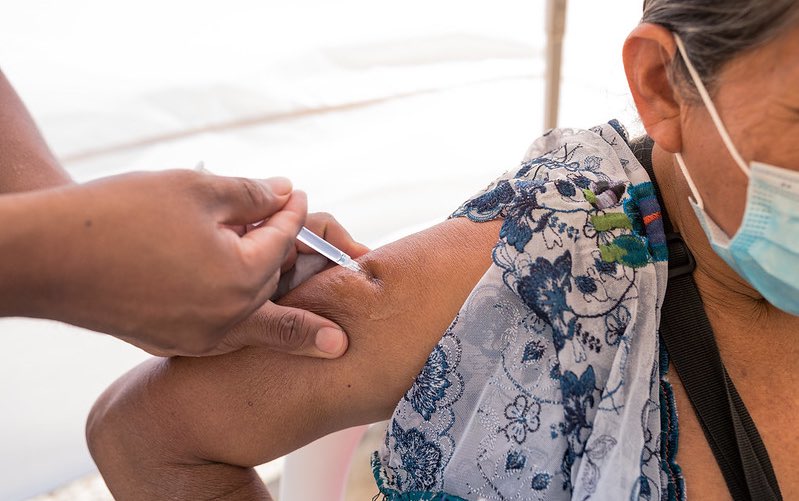India’s devastating second wave of COVID-19 is adding unprecedented numbers of new cases every day, and it seems to be spreading more to rural areas. This trend poses serious challenges for efforts to contain the disease, as rural areas may have heightened pandemic vulnerabilities. It is hard to assess the urban-rural difference globally, as testing and reporting are more challenging in rural areas, but research findings from the United States show higher COVID-19 susceptibility and death rates in rural counties. This pattern aligns with our recent analysis that assessed the risk of COVID-19 in 12 low- and middle-income countries (LMICs).
To support COVID-19 relief efforts at the subnational level, including targeting of vaccination efforts, we constructed a subnational dataset of key COVID-19 risk indicators and potential risk hotspots for 12 LMICs across Africa, Asia, and Latin America, where tracking of COVID-19 data is only available at the national level. Based on patient data compiled and analyzed worldwide, the science community’s consensus now is that key COVID-19 risk factors include age, sex, and obesity. Being old, male, and obese increases both vulnerability to infection and likelihood of severe illness. Based on each indicator’s COVID-19 death hazard ratio, we computed a composite index for second-level subnational administrative units (i.e., county or district level) using exploratory factor analysis, a statistical technique that reduces the number of variables.
Summary results, as well as individual analyses for Bangladesh, Ethiopia, Ghana, Guatemala, Honduras, Kenya, Mali, Nepal, Niger, Nigeria, Senegal, and Uganda, suggest high levels of COVID-19 risk in rural areas, notably in Bangladesh, Honduras, and Nepal (Fig. 1). Both Bangladesh and Nepal instituted new lockdowns in response to the rapid surge in cases from India. In these countries, 75% and 61% of adults residing in rural areas are at high risk of COVID-19 infection.
New COVID-19 hotspots may continue to emerge in rural areas
Fighting COVID-19 is challenging in rural areas, which suffer from limited access to safe water for personal hygiene, healthcare facilities, and, increasingly, nutritious food. Moreover, critical care facilities that are essential for severe COVID-19 cases are largely absent or unaffordable.
A further vulnerability in rural areas relates to household composition. In analyzing nationally representative household survey data from nine LMICs, we found that, on average, rural households have 25% more elderly members (older than 65) than households in urban areas. While shares are higher among nonagricultural households (73% on average, particularly in Kenya and Uganda), the overall higher shares of elderly members across larger households may render those areas particularly vulnerable to the spread of COVID-19 and worse health and mortality outcomes if outbreaks occur. A recently published modeling analysis also concluded that when low- and high-risk household members frequently interact at home, targeted policy interventions become ineffective.
Another important consideration for protecting rural populations is their role in agriculture. In India, for example, even with the exemption of the agricultural sector from the nationwide lockdown, a lack of migrant workers during the harvest season led to production losses, market closures, food price increases, and food insecurity among urban dwellers. As the pandemic worsens in rural areas, food production might decline, causing severe food security challenges across the country. Even if large food production losses can be avoided, the need of poor families to cover COVID-19-associated health costs and burials of family members will put nutrient-dense foods further out of reach than during the first wave. It is therefore crucial to improve access to rural testing and healthcare facilities to avoid food system disruptions.
Finally, given the high level of variability in COVID-19 risk factors between urban and rural areas, we urge all LMICs to report COVID-19 cases at the subnational level and make data publicly available for targeted interventions and vaccine distributions. Where testing is limited, statistics on excess subnational mortality can be used as a proxy. (As more detailed data become available, we will update our risk hotspot mapping analysis accordingly.) A better understanding of the spread of the disease in rural areas is crucial, given their heightened vulnerability to adverse outcomes due to higher undernutrition and growing malnutrition, more families with elder, and the lack of access to healthcare and clean water.
Jawoo Koo and Carlo Azzarri are Senior Research Fellows with IFPRI’s Environment and Production Technology Division (EPTD); Claudia Ringler is EPTD Deputy Director and the coordinator of the Gender, Climate Change, and Nutrition (GCAN) Integration Initiative; Aniruddha Ghosh is an Associate Scientist with the Alliance of Bioversity International and the International Center for Tropical Agriculture (CIAT).
This work was prepared under the Gender, Climate Change, and Nutrition Initiative (GCAN). GCAN was made possible with support from Feed the Future through the U.S. Agency for International Development (USAID) and is associated with the CGIAR Research Program on Climate Change, Agriculture and Food Security.







